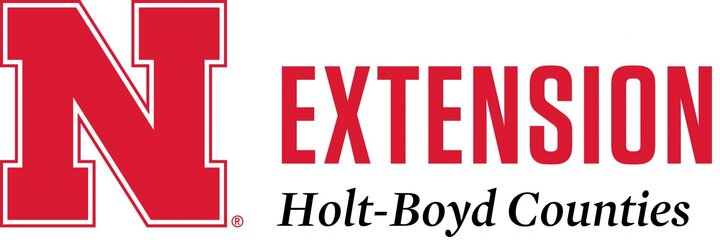
Nebraska Extension Educator - Holt/Boyd Counties - LaDonna Werth
Nebraska Extension Educator - Holt/Boyd Counties - Amy Timmerman
Nebraska Extension Educator - Brown/Rock/Keya Paha Counties - Brittany Spieker
Nebraska Extension Educator - Holt/Boyd/Garfield/Loup/Wheeler Counties - Bethany Johnston
Nebraska 4-H Assistant - Holt/Boyd Counties - Debra Walnofer
April 15: Nebraska Extension Addressing Drought Prep for Cattle Producers, 7:30pm-9:00pm, Holt County Courthouse Annex, O’Neill, NE
April 16-17: Nebraska State 4-H BB Gun and Air Rifle Championships, Christensen Field 1914 Christensen Field Rd, Fremont, NE, https://events.unl.edu/NE4H-Shooting-Sports/2025/03/15/
April 17: DUE: Registrations for the Holt and Boyd Communication Event. Entries open April 10th. https://holt.fairwire.com/ OR https://boyd.fairwire.com/
April 17: Irrigation Efficiency Ratios For Profit and Productivity, 12pm, Zoom, Register at: https://unl.zoom.us/webinar/register/WN_4XcyljnoTaeQs9g1lR11fg#/registration
April 26: Holt County 4-H Shooting Sports Practice; BB Gun, Air Pistol, Air Rifle, Small Bore Pistol, and .22 Rifle; 4pm, 5pm, and 6pm, Holt County Fairgrounds, Chambers, NE
April 26: 4-H Shooting Sports Leader Update Workshop, Hastings, Early bird registration (lower price in training) is April 16 https://events.unl.edu/NE4H-Shooting-Sports/ (Early Bird registration deadline is April 16, 4 pm CT. Registration fee goes up after 4pm CT on April 16 and registration will close on Friday, April 18, 4 pm CT.)
April 26-27: 4-H Shooting Sports Leader Certification Workshop, Hastings, Early bird registration (lower price in training) is April 16 https://events.unl.edu/NE4H-Shooting-Sports/ (Early Bird registration deadline is April 16, 4 pm CT. Registration fee goes up after 4pm CT on April 16 and registration will close on Friday, April 18, 4 pm CT.)
April 27: Boyd County 4-H Communications Event, 3pm, Boyd County Courthouse, Butte, NE
April 27: Holt County 4-H communications Event, 5pm, Holt County Courthouse Annex, O’Neill, NE
April 29: Face-to-Face YQCA Training, 7pm, Holt County Courthouse Annex,
Gardening with Kids
Spring has sprung and garden fever is in the air. What better way to get kids outside than to plant a garden? Making the whole garden experience a family affair can be an extension of the classroom in the outdoors. It also gives youth an opportunity to learn where their food comes from and connect them to nature.
Where do you start? Now is the time to start with the planning process. Including every member of the family in this step, gives them ownership in the garden. First, decide what your family is going to plant and where. To ensure a great gardening experience with kids, start small. Making it an overwhelming process will mostly likely deter interest in the garden. Deciding what types of vegetables or flowers can vary for the area you are in. Also, the smaller the kids, the larger the seeds should be. The seeds should be big enough for small hands to handle. These seeds might include peas, beans, sunflowers, squash or watermelon. These plants will also germinate and grow quickly and are great plants to start inside if you want to start your garden early.
If kids are older, consider planning a theme garden such as a pizza garden or a salsa garden. When temperatures are right for the area, begin the planting process. Having kids help read the seed packets and figure out when, how deep, and how far apart to plant the seeds helps to make them be more involved and committed.
If kids are responsible for watering and weeding, they will learn quickly how the garden will grow. Using appropriately sized watering cans is important for different age children. Try to do all you can to make it a positive experience. If it is difficult, kids will lose interest quickly.
LaDonna Werth
Extension Educator
Phone: 402-336-2760
E-mail: lwerth2@unl.edu

Thinking of the garden as an outdoor classroom can open new learning opportunities. Here are ways to capture that learning experience:
- Point out and identify bugs.
- Research what plants go best together.
- Measuring and tracking plant growth allows youth to use their math skills.
- Having youth decorate plant sticks with the name of plants on them uses their creative skills. This also helps to keep track of what plants are in the garden.
Enjoy the time in the garden! It does not have to be big or complicated. Share your enthusiasm. Remember you are planting a seed that with a little time and encouragement can grow into something amazing!
More resources for gardening can be found at Nebraska Extension: https://extensionpubs.unl.edu
Source: Rhonda Herrick - Extension Educator (UNL for Families – April 11, 2025)
Using Irrigation Scheduling Tools to Save Water Without Sacrificing Yield
Key Takeaways
- Water Savings: In a 2024 Nebraska On-Farm Research Network field study using a commercial irrigation scheduling tool, researchers found tool-managed areas used less water than grower-managed areas.
- Yield and Profitability: Despite reduced water use, there were no significant differences in yields or marginal net returns between the standard method and scheduling tool method.
- Decision-Making Support: Scheduling tools help integrate complex factors (soil type, crop stage, weather, etc.), making irrigation decisions more data-driven and consistent.
Irrigation scheduling tools can help growers reduce water use while maintaining crop yields. In 2024, the Nebraska On-Farm Research Network (OFRN) highlighted this potential through a series of irrigation-focused trials.
Nebraska OFRN offers growers a chance to test new management practices on their own farms in collaboration with extension educators. The goal was to find ways to reduce input costs and sustain or enhance crop production - all while supporting environmental stewardship. By using replicated, field-scale research, OFRN trials provide growers with data-driven insights that can encourage the adoption of proven alternative practices.
Amy Timmerman
Extension Educator
Phone: 402-336-2760
E-mail: atimmerman2@unl.edu

A key focus in the 2024 growing season was a set of four irrigation scheduling trials - three in Platte County and one in Butler County. These trials compared the growers' standard irrigation decisions with those made using a commercial irrigation scheduling tool. Two trials were conducted on soybeans and two on corn. In each case, half of a center pivot was used for the trials. Three replications were managed using the grower’s usual approach, and the three sections used the scheduling tool to guide irrigation decisions.
An example of one trial in Platte County involved a center pivot equipped with the FieldNET™ system by Lindsay enabled variable irrigation rates using speed control. This allowed each section of the pivot to apply different amounts of water based on the respective management approach, based on a speed control variable rate irrigation.
The results: On average, the grower-managed sectors received 5.2 inches of irrigation during the 2024 growing season. In comparison, the tool-managed sectors used 1.2 inches less water. Corn fields saw an average savings of 1.5 inches, while soybean fields saved about 0.9-inch. Despite the reduced water use, yields and marginal net returns were statistically the same between the two approaches — meaning growers could potentially reduce irrigation without sacrificing profitability.
Irrigation decisions are influenced by multiple factors, including soil type, soil water holding capacity, crop growth stage, crop water use, weather conditions and pumping capacity among others, which can make irrigation decision complex. Using an irrigation scheduling tool helps integrate these variables, promoting more consistent and data-driven irrigation management.
The results can be found in the 2024 On-Farm Research Results book (pages 189-192). Feel free to contact Bruno Lena at (402) 563-4901 for more information.
Source: Bruno Lena – Extension Educator (CropWatch – April 10, 2025)
Tips for Managing Cow-Calf Pairs Through a Drought
Despite many in the Great Plains region receiving a few inches of snow this past month, the past several months of drought and a forecasted dry summer are likely to reduce grass production in many areas. Making a drought management plan before summer will help producers be proactive in decision making as opposed to reactive as drought forces management changes.
Making Culling Decisions Early
The cull cow market has started its seasonal trend upward and is showing promise of being favorable to the cow-calf producer again this year. Therefore, producers facing loss of grass due to drought may want to designate older cows, cows with bad quarters on their udders, those who produce a lower than average calf, or have disposition issues for an early weaning program to reduce grazing pressure and take advantage of the seasonal peak in the cull cow market. High-risk cows such as 2 and 3 year old cows with young calves might be culling options as they could be sold as pairs prior to breeding to producers with more stable feed resources.
Stretching the Grass with Supplemental Feed
Those fortunate enough to have equipment for mixing and feeding total mixed rations (TMR) may want to consider feeding a TMR in a pasture area to stretch the grass available. Research conducted at the University of Nebraska showed that mixing wet distillers grains and poor quality roughage such as ground crop residue could replace 0.22 to almost 1 pound of dry matter intake of pasture grass. While this does not prevent overgrazing of a pasture, it can buy producers a little time allowing delayed turn out and recovery for other drought stricken pastures. However, just supplying 1-2 pounds of a protein supplement on pasture will not reduce forage intake; in fact, it will increase it by increasing digestion.
Bethany Johnston
Extension Educator
Phone: 402-336-2760
E-mail: bjohnston3@unl.edu

Feeding Pairs in Confinement
Housing cow-calf pairs in a drylot, on a pivot corner, fallow ground, or sacrifice pasture and feeding a TMR can also be a way to manage cattle through a drought. Although a TMR is often the easiest way to do this, producers can also be creative in how they feed in confinement. Those who do not have a means of grinding, mixing, and delivering a TMR or procuring wet distillers grains can also roll out hay, use a bale processor, and supplement a protein and energy source such as dried distillers or soybean meal and corn gluten feed or soyhulls in a bunk or on top of the forage fed out. There are three important things to remember when feeding pairs in confinement:
Lactation requires almost double the protein and energy that late gestation does. Therefore, supplying protein, energy, and a mineral and vitamin supplement that meets the demands grazed grass will not must be included.
A 3 month old nursing calf will be consuming about 1.5% of his body weight on a dry matter basis of the feed provided.
The feed needs to be spread out to provide about 2 feet of feeding space for cows and 1 foot per calf, especially if dry matter intake is somewhat limited.
Early Weaning
Removing lactation from the cow can decrease her dry matter intake by roughly 20%. Removing the calf from the pasture also reduces the grazing pressure on the pasture. The calf can then be sold or can be grown in a drylot setting until a more traditional date for selling. However, producers will likely want to calculate the value of the calf at early weaning vs. the value of the calf sold at a later date minus the feed and labor associated with maintaining the calf for the extra time to see if it is financially beneficial.
Summary
Making management decisions for drought mitigation are never easy. However, having a plan in place early in the grazing season is likely to result in a more positive outcome than taking a wait and see approach and being forced to be reactive. Culling some less productive cows, stretching pasture, feeding in confinement, and early weaning are all options to consider when developing a drought mitigation plan. The University of Nebraska has beef focused educators and specialists available to assist with ration balancing and decision making.
Source: Karla Wilke - Nebraska Extension Cow/Calf Systems and Stocker Management Specialist (BeefWatch – April 1, 2025)
Go Bananas - Celebrate National Banana Day the Healthy Way!
Wednesday, April 16th marks National Banana Day, a perfect time to celebrate one of the most popular fruits! Whether you’re a fan of enjoying them on their own or incorporating them into a variety of dishes, bananas are a versatile and affordable option for any meal or snack.
Why Bananas?
Bananas are more than just a convenient, grab-and-go fruit. They’re packed with essential nutrients that support overall health. A single banana provides about 400 milligrams of potassium, which is important for supporting muscle function, as well as, a healthy heart and blood pressure levels. Bananas are also great for fiber, vitamin C, and vitamin B6 - supporting your immune system, energy levels, and overall wellness.
Beyond their impressive nutritional profile, bananas are also an easy addition to almost any meal plan. Whether you enjoy them as a snack, blended into smoothies, or baked into your favorite treats, bananas offer endless possibilities.
Fun Ways to Celebrate National Banana Day
Looking for ways to enjoy bananas this National Banana Day? Here are a few fun and healthy ideas to inspire you:
Brittany Spieker
FNH Extension Educator
Phone: 402-387-2213
E-mail: bspieker2@unl.edu

- Banana Smoothie Bowls – Blend frozen bananas with your choice of milk and your favorite fruits - berries, mango, or even spinach - for a refreshing smoothie bowl. Top with granola, seeds, or chopped nuts for added texture. Not only is it delicious, but it’s packed with essential vitamins, minerals, and fiber.
- Banana Pancakes – Give your regular pancakes a healthy twist by adding mashed bananas to the batter. The natural sweetness of bananas will reduce the need for added sugars, making this breakfast option both nutritious and tasty.
- Banana Bread – A classic favorite, banana bread is the perfect way to use up overripe bananas. It makes for a great snack or breakfast option. For a healthier twist, try swapping out some of the butter or oil for Greek yogurt, or use half whole grain flour and half all-purpose flour to boost fiber without drastically changing the texture of your bread.
- Frozen Banana Snacks – For a cool, refreshing treat, peel and slice bananas, then freeze them for a delicious snack. They’re perfect on their own, or you can dip them in dark chocolate or nut butter for a fun twist.
Bananas: A Budget-Friendly Option
Bananas are one of the most affordable fruits available, making them an excellent choice for anyone looking to eat healthy without breaking the bank. They are inexpensive year-round, available at nearly every grocery store, and require no special preparation. Their long shelf life, especially when stored properly, means less waste and more value for your money. Whether you're blending them into a smoothie, adding them to oatmeal, or enjoying one as a simple snack, bananas are a convenient and cost-effective way to boost your nutrition.
Celebrate the Day!
This National Banana Day, take a moment to appreciate the banana and all it has to offer. With its versatility, affordability, and health benefits, it's no wonder that bananas continue to be a beloved fruit in households everywhere. So, grab a bunch, get creative in the kitchen, and celebrate this banana-mazing day!